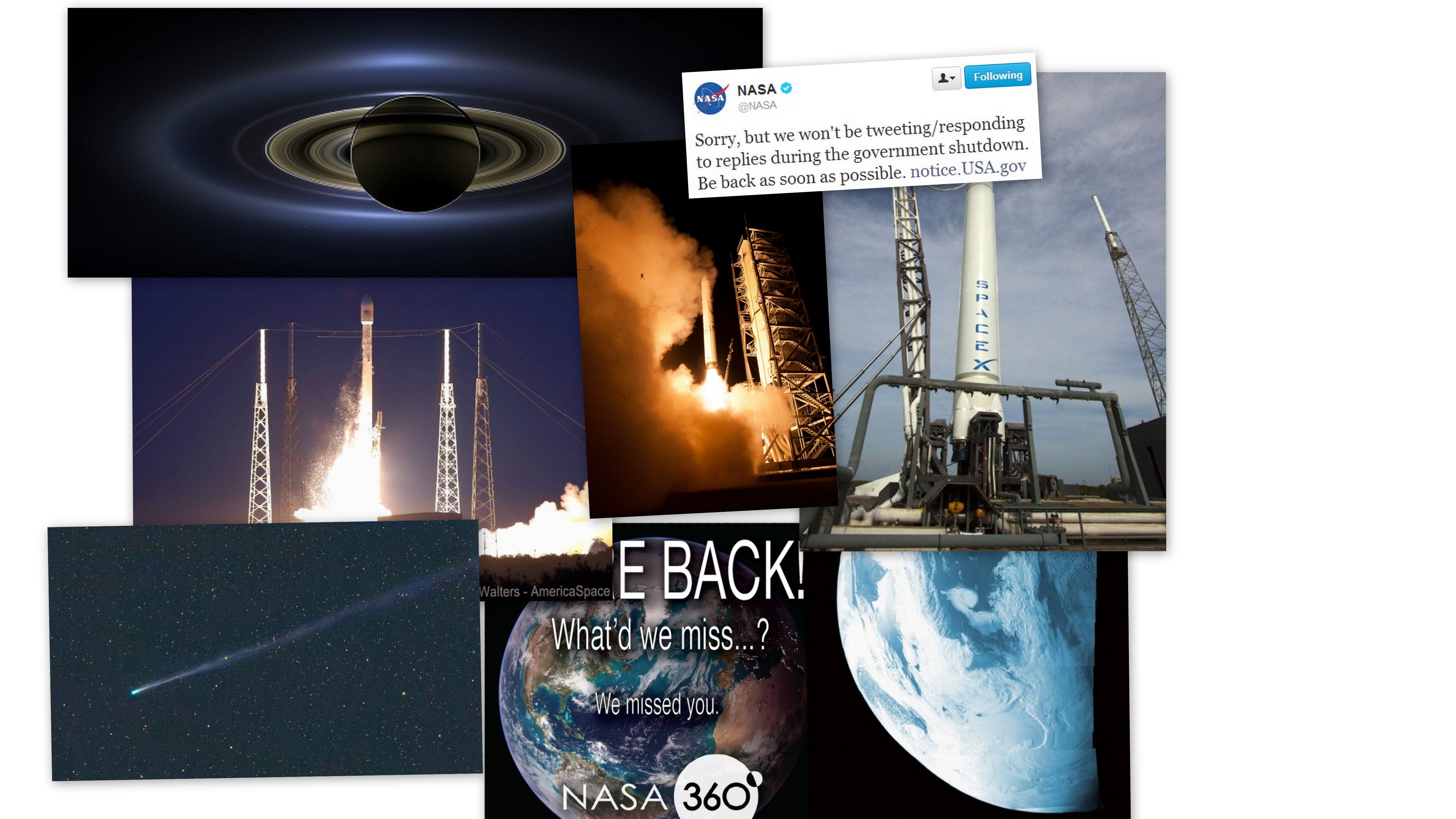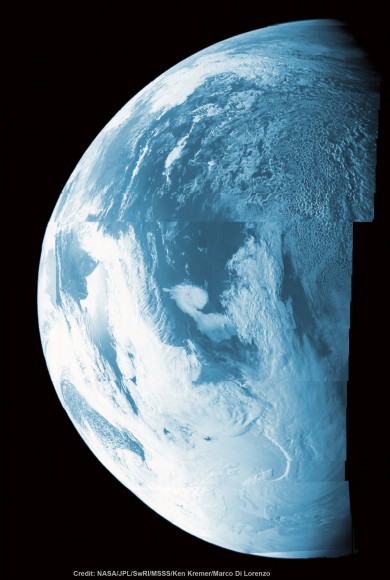

2013 has been quite the year in space and astronomy! There have been launches, new missions, new discoveries and surprises. Here’s a look back at the big news from the past year, and since we never can limit ourselves to just a “Top 10” here are the “Top 12” stories we’ve featured on Universe Today in 2013, as chosen by our staff:


12. Juno Flyby
During a crucial speed boosting slingshot maneuver around Earth on Oct. 9, 2013 NASA’s Jupiter-bound Juno probe snapped a dazzling gallery of portraits of our Home Planet over the South American coastline and the Atlantic Ocean. However, an unexpected glitch during the “do or die” fly-by sent the spacecraft into ‘safe mode’ and delayed the transmission of most of the raw imagery and other science observations while mission controllers worked hastily to analyze the problem. But five days later engineers finally recouped Juno and it’s been smooth sailing ever since.
“Juno is fully operational and on its way to Jupiter,” Juno principal investigator Scott Bolton told Universe Today’s Ken Kremer. “We are completely out of safe mode!”
11. The US Government and NASA shutdown
Due to budgetary disagreements in Congress, the United States federal government began a shutdown on Oct. 1, 2013 that affected all government agencies and an untold number of government contractors. During the shutdown, which lasted for 16 days, about 97% of NASA’s 18,000 employees were off the job. NASA’s websites were pulled, all the NASA-associated Twitter, Facebook, Google Plus and other social media accounts went dark and NASA Television has also ceased broadcasting.
Thankfully, NASA’s MAVEN Mars orbiter was granted ‘emergency exemption’ to resume processing for its launch, (otherwise, the launch may have been delayed for two years) and the mission launched successfully on Nov. 18.
Read more about the government shutdown here and here.
10. Cassini Takes a Picture of Earth from Saturn’s orbit:
This summer, for the first time ever, the world was informed that its picture was going to be taken from nearly a billion miles away as the Cassini spacecraft captured images of Saturn in eclipse on July 19. On that day we were asked to take a moment and smile and wave at Saturn, from wherever we were, because the faint light from our planet would be captured by Cassini’s camera, shielded by Saturn from the harsh glare of the Sun.
This was no simple point-and-click. Over 320 images were captured by Cassini on July 19 over a period of four hours, and this mosaic was assembled from 141 of those images. Because the spacecraft, Saturn, and its moons were all in constant motion during that time, affecting not only positions but also levels of illumination, imaging specialists had to adjust for that to create the single image you see above. So while all elements may not be precisely where they were at the same moment in time, the final result is no less stunning.
Read more about it here.
9. Commercial space takes off
It was a big year for commercial space. SpaceX successfully launched their Dragon capsule on a second resupply mission to the International Space Station in March. The launch, rocket stage and spacecraft separations went perfectly, but the Dragon experienced an unexpected failure in the propulsion system that would bring it to the ISS. But SpaceX — with some help from the Air Force — saved Dragon from doom, and the resupply mission went off spectacularly. You can read about what’s ahead in 2014 for the human-rated Dragon here. SpaceX also launched their next generation Falcon 9, and continued their work on the Grasshopper.
In September, Orbital Sciences launched their Cygnus spacecraft for their first resupply mission to the ISS, with great success.
China scored success with the successful touchdown of the ambitious Chang’e-3 probe with the ‘Yutu’ rover on the surface of the Moon on Dec. 14, 2013. This was China’s first ever attempt to conduct a landing on another planetary body, and was the first landing on the Moon by any entity in nearly four decades.
In November, India’s first ever Mars probe Mars Orbiter Mission (MOM) blasted from Earth for a rendezvous with the Red Planet on September 24, 2014 – where it will study the atmosphere and sniff for signals of methane. Read more here.
7. NASA launches Missions to Mars and the Moon: MAVEN, LADEE
NASA’s latest mission to the Moon, LADEE, launched from Wallops Island in Virginia on September 6, lighting up the sky along the US East Coast, allowing millions to see the Minotaur V rocket’s brilliance with their own eyes, cheering the Lunar Atmosphere and Dust Environment Explorer as it sailed to orbit. A frog made headlines as it ended up being flung into the air during the launch. LADEE successfully entered lunar orbit on Oct. 6 amidst the government shutdown
NASA’s Mars Atmosphere and Volatile Evolution (MAVEN) space probe thundered to space on Nov. 18 from Cape Canaveral Air Force Station’s Space Launch Complex 41 on an Atlas V rocket. MAVEN’s purpose is to answer key questions about the evolution of Mars, its geology and the potential for the evolution of life.
“MAVEN is an astrobiology mission,” says Bruce Jakosky, MAVEN’s Principal Investigator.
Read more about MAVEN’s launch here.
It’s been known since 2005 that Saturn’s moon Enceladus has geysers spewing ice and dust. Now, thanks to the Hubble Space Telescope we know of another moon with similar jets: Europa, the ever-enigmatic ice-shelled moon of Jupiter. This makes two places in our Solar System where subsurface oceans could be getting sprayed directly into space — and within easy reach of any passing spacecraft.
Coupled with another discovery of clays on Europa’s icy surface, like delivered by comet crashes, this makes Europa a top candidate for missions, according to planetary researchers.
5. Kepler’s Demise… or maybe not
We were given the sad news in May that NASA’s exoplanet-hunting Kepler telescope had lost its ability to precisely point toward stars, due to two of four reaction wheels failing, putting its exoplanet search in jeopardy.
But as scientists looked for new ways to use Kepler, they determined it could still be able to seek out potentially-habitable exoplanets around smaller stars. In fact, in its new 2-wheel mode, Kepler might actually open up a whole new territory of exoplanet exploration looking for Earth-sized worlds orbiting white dwarfs.
4. Curiosity and Opportunity rovers discover habitable zones
This year, NASA’s Curiosity rover discovered evidence that an ancient Martian lake had the right chemical ingredients that could have sustained microbial life forms for long periods of time – and that these habitable conditions persisted on the Red Planet until a more recent epoch than previously thought. Additionally, researchers have developed a novel technique allowing Curiosity to accurately date Martian rocks for the first time ever – rather than having to rely on educated guesses based on counting craters.
Meanwhile, the venerable Opportunity rover, going on nearly a decade of roving on Mars, spotted deep stacks of ancient rocks transformed by flowing liquid water eons ago.
Read more about Oppy’s discovery here.
3. Voyager I enters interstellar space
In a cosmically historic announcement on September 12, 2013, NASA said the most distant human made object — the Voyager 1 spacecraft — is in interstellar space, the space between the stars. It actually made the transition about a year ago.
While there is a bit of an argument on the semantics of whether Voyager 1 is still inside or outside of our Solar System (it is not farther out than the Oort Cloud — it will take 300 more years reach the Oort cloud and the spacecraft is closer to our Sun than any other star) the plasma environment Voyager 1 now travels through has definitely changed from what comes from our Sun to the plasma that is present in the space between stars.
2. Comet Mayhem: ISON’s dusty end and Lovejoy’s surprise
2013 was billed as the Year of the Comet, as several comets were expected to reach naked-eye visibility. There was Comet C/2011 L4 PANSTARRS, C/2012 F6 Lemmon, and the one everyone was waiting for, Comet C/2012 S1 ISON. ISON ended up not making it past its close encounter with the Sun, but we are now being rewarded with another early morning comet, Comet C/2013 R1 Lovejoy.
1. The Chelyabinsk Meteor
Just as anticipated, on Friday, Feb. 15, asteroid 2012 DA14 passed us by, zipping 27,000 kilometers (17,000 miles) above Earth’s surface — well within the ring of geostationary weather and communications satellites that ring our world.
But before that close pass occurred, there was a completely unexpected appearance of a remarkably large meteor in the skies over Chelyabinsk, Russia on the morning of the same day, surprising scientists and causing damage and injuries to the unsuspecting residents of the city. While this event provided insight and information about what happens when an asteroid intersects with Earth, it also highlighted the need for continued research of near-Earth objects (NEOs) — since there are plenty more out there where these came from.
————————————–
That’s it for 2013, and here’s to more great stories in 2014! We’ll continue to do our best to provide coverage on everything space and astronomy-related in the year to come, and thanks to all our readers for your continued support and comments. Also, I want to extend my thanks to our excellent staff of writers who contributed news articles this past year: Jason Major, Elizabeth Howell, Ken Kremer, David Dickinson, Bob King, Tammy Plotner, Shannon Hall, Daniel Majaess, Markus Pössel, Markus Hammonds, Ray Sanders, Scott Lewis, Matthew Francis, John Williams, Susan Murph and Brian Koberlein. Special thanks to our amazing publisher Fraser Cain for his leadership and support (and his great new video series this year!)
Happy New Year!
How can we explore Saturn’s moon, Enceladus, to include its surface and subsurface ocean, with…
Have you ever wondered how astronomers manage to map out the Milky Way when it's…
NASA astronomers have been continuing to monitor the trajectory of asteroid 2024 YR4. The initial…
Some exoplanets have characteristics totally alien to our Solar System. Hot Jupiters are one such…
Stars form in Giant Molecular Clouds (GMCs), vast clouds of mostly hydrogen that can span…
Let’s dive into one of those cosmic curiosities that's bound to blow your mind: how…